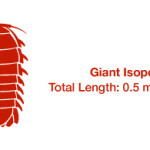 The phylum Porifera (sponges; “pore bearing) is divided into three classes, Hexactinellida, Demospongiae, and Calcarea. Calcarea is the oddball of the group, building skeletal elements out of calcium carbonate (like corals and snails) instead of silica. The Hexactinellids (glass sponges) of which I will focus on, are predominately a deep sea group. They are the oldest of the groups originating about 585-720 million years ago during the Snowball Earth period. During this time, soluble calcium carbonate and silica were formed by reaction with atmospheric carbon dioxide. These reactions provided silicic acid in seawater-the necessary starting material for siliceous spicules. In marine environments, silica concentrations are relatively low, thus the need to augment the process with enzymes. Sponges are unique in that silica deposition is mediated by an enzyme (silicatein). Other organism like diatoms do not enzymatically bolster the process. Spicule formation begins within the cell and extruded when it becomes to large (6-8 micrometers). In the deep sea the higher concentrations of of silica/silicon allow for formation of larger sponges (i.e. if your a sponge the deep sea may be the good life). Within the Hexactinellids, one deep-sea species produces spicules over 3m (9.8ft) in length, making them the largest biosilica structures on earth.
The phylum Porifera (sponges; “pore bearing) is divided into three classes, Hexactinellida, Demospongiae, and Calcarea. Calcarea is the oddball of the group, building skeletal elements out of calcium carbonate (like corals and snails) instead of silica. The Hexactinellids (glass sponges) of which I will focus on, are predominately a deep sea group. They are the oldest of the groups originating about 585-720 million years ago during the Snowball Earth period. During this time, soluble calcium carbonate and silica were formed by reaction with atmospheric carbon dioxide. These reactions provided silicic acid in seawater-the necessary starting material for siliceous spicules. In marine environments, silica concentrations are relatively low, thus the need to augment the process with enzymes. Sponges are unique in that silica deposition is mediated by an enzyme (silicatein). Other organism like diatoms do not enzymatically bolster the process. Spicule formation begins within the cell and extruded when it becomes to large (6-8 micrometers). In the deep sea the higher concentrations of of silica/silicon allow for formation of larger sponges (i.e. if your a sponge the deep sea may be the good life). Within the Hexactinellids, one deep-sea species produces spicules over 3m (9.8ft) in length, making them the largest biosilica structures on earth.

The creation of that giant spicule is not a simple process. The process occurs through successive deposition of layers (lamella, layers 2-4 show subsequent growth). The center of the spicule contains a filament (af in figure below) around which the first lamella formed. Lamella deposition is mediated by silicatein-related proteins (red ellipsoid dots) arranged on the previous lamella and a proteinaceous cage eventually disintegrated (indicated in b2). The cage is stabilize by lectin (complex molecule of protein and sugur) molecules (yellow dots). The actual solid silica lamella (pale green) is formed through combination of silica clusters (grey circles). The concentric arrangement of the silicatein(-related) proteins/lectin associates is proposed to be stabilized by collagen (gray x’s)






